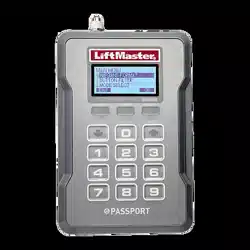
1
To prevent possible SERIOUS INJURY or DEATH from electrocution:
• Be sure power is NOT connected BEFORE installing the receiver.
To prevent possible SERIOUS INJURY or DEATH from a moving gate
or garage door:
• ALWAYS keep remote controls out of reach of children. NEVER
permit children to operate, or play with remote control transmitters.
• Activate gate or door ONLY when it can be seen clearly, is properly
adjusted, and there are no obstructions to door travel.
• ALWAYS keep gate or garage door in sight until completely closed.
NEVER permit anyone to cross path of moving gate or door.
WARNING
CAUTION
WARNING
WARNING
To prevent possible SERIOUS INJURY or DEATH, the use of
CONSTANT OPERATION on residential openers is PROHIBITED.
When a receiver is used to activate a commercial door opener, a
reversing edge MUST be installed on the bottom of the door. Failure to
install a reversing edge under these circumstances may result in
SERIOUS INJURY or DEATH to persons trapped beneath the door.
PASSPORT WIEGAND RECEIVER
MODEL PPWR
APPLICATION
The Passport Wiegand Receiver is a Security+ 2.0
®
receiver with a
Wiegand output. The PPWR is compatible with Security+ 2.0
®
Passport
MAX and Passport Lite remote controls and access systems utilizing 26
Bit, 30 Bit, 31 Bit, 34 Bit (even or odd), and 50 Bit Wiegand code formats.
The receiver has two modes of operation (see Choose a Mode,
page 3):
• Pass Through Mode (Default) - passes all received remote control
signals to the access system host controller.
• Advanced Mode - provides an additional layer of security in areas
where other remote controls may be operating. The receiver only
passes signals from a remote control with a previously programmed
facility code. All other signals are blocked.
This receiver is compatible with HomeLink
®
. Refer to instructions
included with your HomeLink
®
unit for compatibility and programming.
The receiver is rated for outdoor use (IP44).
INSTALLATION
1. Select a convenient location near the access system host controller
within “line of sight” of the intended transmitting location.
NOTE: Do not mount the receiver in direct sunlight. Avoid mounting
the receiver in a metal enclosure or near other wireless receiving or
transmitting devices. If mounted in a metal enclosure, a remote
antenna must be used. If using multiple receivers, maximize the
distance between the two to avoid interference.
2. Mount the bracket to the desired surface with appropriate hardware
(not provided)(Figure 1).
3. Remove the 4 #8 screws on the back of the receiver and remove the
faceplate. Unplug the keypad connector from the control board.
NOTE: Be careful not to damage the keypad cable while removing the
faceplate.
4. Make wiring connections (Figure 2). Refer to your access system
host owner’s manual for more specific information.
5. Reconnect the keypad connector to the board (labeled J9).
6. Secure the faceplate with the 4 #8 screws previously removed.
7. Install the antenna (provided).
Figure 1
Mounting Bracket
Antenna
Connector
Backup Memory
Module
Figure 2
Data 1 (to host)
Data 0 (to host)
12-24 VDC (+ Power Input)
- Power Input (Ground)
Shield
LED (from host Optional)
Watertight Connector
J9
Keypad Connector
Receiver Without
Faceplate
NOTE: Use the optional 86LM or 86LMT antenna extension kit
(see page 4) to mount the remote antenna as high and far from
metallic objects as possible for best radio range.
8. Snap receiver onto the mounting bracket and secure with the
#8 screws provided.
9. Tighten the watertight connector to secure and seal the wiring.
WARNING: This product can expose you to chemicals including
lead, which are known to the State of California to cause cancer
or birth defects or other reproductive harm. For more information
go to www.P65Warnings.ca.gov
Loading ...
Loading ...
Loading ...
